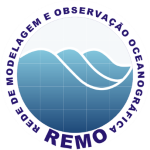Forecast date and time
Select a product
Choose an area
Settings
Use the controls below to increase and decrease speed and width of wave movement on the map.
In certain areas and times, waves may be at low speed. By increasing the speed and increasing the width, it is possible to better observe some phenomenons.
Use the control below to increase or decrease the player's loop time.
If it is on, at each zoom in or out, the system will increase or decrease the amount of displayed flows.
REMO
The Oceanographic Observation and Modeling Network (REMO) is a Brazilian effort in physical oceanography and operational oceanography conducted by a group of researchers, technicians and students associated with universities, research centers and the Brazilian Navy, funded by Petrobras and the National Agency of Petroleum, Natural Gas and Biofuels ( ANP).
The overall goal of REMO is the development of science and technology in physical oceanography, ocean modeling, observational oceanography and operational oceanography with data assimilation.

ADCIRC Model
For the development of this application, the Advanced Circulation Model (ADCIRC), was chosen as the coastal modeling tool. ADCIRC is developed and maintained by researchers from the University of North Carolina and University of Notre Dame, USA.
This model solves the equations of motion for rotating fluid systems, with spatial discretization using the finite element method and temporal discretization using finite differences. ADCIRC is used by several institutions to generate circulation forecasts in coastal regions of significant economic activity, such as ports and bays.
To generate the results presented by the PAM app, the ADCIRC model is executed coupled with the Simulating Waves Nearshore (SWAN) wave model. It uses atmospheric boundary conditions from the COSMO model, oceanographic boundary conditions from the HYCOM model, and wave boundary conditions from the WW3 model. All the mentioned models run in the CHM.
General characteristics of the ADCIRC model:
- Open-source model;
- Unstructured grid;
- Parallelized code;
- Coupling module with the Simulating Waves Nearshore (SWAN) model;
- Active and widely used discussion forum.